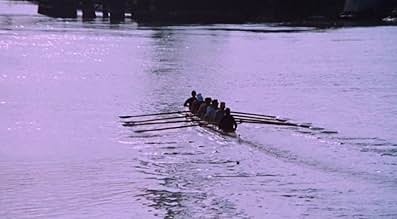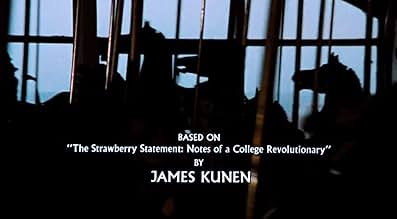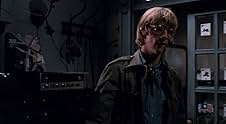NOTE IMDb
6,6/10
1,9 k
MA NOTE
Ajouter une intrigue dans votre langueAn apolitical college student joins a group of campus protesters to meet girls but gets swept up in their cause and involved in a violent confrontation with police.An apolitical college student joins a group of campus protesters to meet girls but gets swept up in their cause and involved in a violent confrontation with police.An apolitical college student joins a group of campus protesters to meet girls but gets swept up in their cause and involved in a violent confrontation with police.
- Réalisation
- Scénario
- Casting principal
- Récompenses
- 1 victoire et 2 nominations au total
Avis à la une
This movie will be of interest to anyone curious about the mores, attitudes, fashions, and lifestyles of the those involved in the radical student movement of the late 1960s. It presents a compelling portrait of the times. Personally I was left with the impression that the students were largely naive, spoiled idiots, and I found it difficult to sympathize with their agenda and methods. Nevertheless, I did feel for the duration of the movie that I was immersed in a reasonable, realistic representation of those times. The movie presents a more reality-based view of the late 60s than hippy freakout pieces like "Easy rider," for example, so you the viewer is advised to look at it as a kind of window into an era gone by.
Simon (Bruce Davison) is an apolitical college rower in San Francisco. He is indifferent to the mounting protest on campus about stealing an African-American playground for the ROTC headquarter. He drops by to watch the protest and is taken with Linda (Kim Darby). He follows her into a student takeover of the administration building.
This is a counter-culture film or a counter-counter-culture film. It could be a simple straight stiff turns hippie radical. It does take some unexpected turns. He's not a simple nice guy. There are darker edges. The couple has a difficult encounter with the very black people that they're trying to help. It's not all flower power. I don't buy the shopkeeper. His actions don't feel right. It would be so much better for him to placate and cooperate with the couple before calling the cops. Instead, he's raising his hands which make it less shocking to have him call for the cops. Anyways, it all struck me wrong. There are a couple of notable actors but mostly it looks like an amateur cast. Kim Darby is cute coming a year after True Grit. It all adds up to a lesser, interesting counter-culture film.
This is a counter-culture film or a counter-counter-culture film. It could be a simple straight stiff turns hippie radical. It does take some unexpected turns. He's not a simple nice guy. There are darker edges. The couple has a difficult encounter with the very black people that they're trying to help. It's not all flower power. I don't buy the shopkeeper. His actions don't feel right. It would be so much better for him to placate and cooperate with the couple before calling the cops. Instead, he's raising his hands which make it less shocking to have him call for the cops. Anyways, it all struck me wrong. There are a couple of notable actors but mostly it looks like an amateur cast. Kim Darby is cute coming a year after True Grit. It all adds up to a lesser, interesting counter-culture film.
Style tells the story here or at least what there is of it. But don't expect much dialog or exposition. Instead it's a swirling camera and incessant movement that impart mood and progression. Simon's an ordinary college student until he's drawn into the student protests of the turbulent 1960's. There he more or less discovers a 'true self' and becomes a leader of the movement, along with his now co-activist Linda, drawn together by the exhilaration of events.
Despite frustrations with what seems at times a self-indulgent approach, there are some good touches. Catch how Simon's previous life is summed up by the regimentation of the rowing team. There's even an overlay of barbed wire to emphasize the point. I guess that makes up for the absence of a peek into his home life. Moreover, Simon's fantasy moments are also strategically inserted, thereby avoiding dialog to account for his actions. Thankfully, however, the device is not over-used.
On a more personal note-- as a student activist (SDS) of the time at a large metropolitan university, I'd like to offer a couple observations. The movie barely mentions the war then raging in Vietnam. Yet in my experience, it was a prime motivational factor, especially with the draft breathing down so many male necks in behalf of a bloody politician's war. Also, there's almost no political theory discussed even briefly in the movie's fast-moving kaleidoscope. Instead, the movement's leftist orientation is imparted visually by repeated images of an iconic Che Guevara.
The strike we mounted at my school failed to come off when an important student group opposed it. As a result, the movement there soon faded away. In the movie, however, the police violently overwhelm the student strike. Nonetheless, the police action appears over-dramatized even if correct in essentials. This latter I base on what I experienced at the so-called Century City riot of June, 1967, in west LA. There an all-white march of mostly respectable adults ended at a hotel where President Johnson was to speak. Planners however failed to provide an exit route and the crowd soon overflowed with bunched up marchers. Both police and protesters panicked and a melee ensued in which many folks were beaten bloody with batons. It's probably the biggest police-white people fracas in LA since that time. I mention this as a perspective on the movie's portrayal of a police take-over of striking students. Over-done though I believe the depiction is, the movie is still correct in the use of random police violence. And though hippie-style free love is at least implied in the movie, my experience was that the political side of protests was clearly distinguishable from hippie-type cultural protest.
Anyway, the film's disruptive style is rather frustrating. But that may be the movie-makers intended effect since the protest movement itself disrupted convention. In that sense, the finished film would amount to an intentionally awkward combining of style and content in order to better depict turmoil surrounding real student protest. To me, however, some essentials that depend more on words than visuals get unfortunately left out.
All in all, I think the movie does capture a sense of new-found-freedom as the students rebel against a background of 1950's conformity. At the same time, the protest gatherings also provided an educational exposure to many of the country's most vital but suppressed realities. Sure, SS may not be the best student movie of that time, but it does have its moments.
Despite frustrations with what seems at times a self-indulgent approach, there are some good touches. Catch how Simon's previous life is summed up by the regimentation of the rowing team. There's even an overlay of barbed wire to emphasize the point. I guess that makes up for the absence of a peek into his home life. Moreover, Simon's fantasy moments are also strategically inserted, thereby avoiding dialog to account for his actions. Thankfully, however, the device is not over-used.
On a more personal note-- as a student activist (SDS) of the time at a large metropolitan university, I'd like to offer a couple observations. The movie barely mentions the war then raging in Vietnam. Yet in my experience, it was a prime motivational factor, especially with the draft breathing down so many male necks in behalf of a bloody politician's war. Also, there's almost no political theory discussed even briefly in the movie's fast-moving kaleidoscope. Instead, the movement's leftist orientation is imparted visually by repeated images of an iconic Che Guevara.
The strike we mounted at my school failed to come off when an important student group opposed it. As a result, the movement there soon faded away. In the movie, however, the police violently overwhelm the student strike. Nonetheless, the police action appears over-dramatized even if correct in essentials. This latter I base on what I experienced at the so-called Century City riot of June, 1967, in west LA. There an all-white march of mostly respectable adults ended at a hotel where President Johnson was to speak. Planners however failed to provide an exit route and the crowd soon overflowed with bunched up marchers. Both police and protesters panicked and a melee ensued in which many folks were beaten bloody with batons. It's probably the biggest police-white people fracas in LA since that time. I mention this as a perspective on the movie's portrayal of a police take-over of striking students. Over-done though I believe the depiction is, the movie is still correct in the use of random police violence. And though hippie-style free love is at least implied in the movie, my experience was that the political side of protests was clearly distinguishable from hippie-type cultural protest.
Anyway, the film's disruptive style is rather frustrating. But that may be the movie-makers intended effect since the protest movement itself disrupted convention. In that sense, the finished film would amount to an intentionally awkward combining of style and content in order to better depict turmoil surrounding real student protest. To me, however, some essentials that depend more on words than visuals get unfortunately left out.
All in all, I think the movie does capture a sense of new-found-freedom as the students rebel against a background of 1950's conformity. At the same time, the protest gatherings also provided an educational exposure to many of the country's most vital but suppressed realities. Sure, SS may not be the best student movie of that time, but it does have its moments.
I've grown older, I've grown sedated - this was the first time in I don't remember how long that a movie really made me FEEL so much. The music, the camera-work, the speeches, the feeling of just wanting to c h a n g e so much! I got completely wrapped up in it, especially, like someone else wrote, since the state of the world is at it is today; it makes this movie feel more accurate than ever! Why, oh why, aren't there revolutionaries like these on the streets and in the universities of today? One thing though. The movie very accurately portrays women of this time and this movement, and by that I mean they are portrayed either as sexual objects, passive jewelry for the revolutionaries (men) to lean on in their "headquarter" (in this case the dean's office)or as frail and beautiful little birds the men have to care for. It is true that this is how women of the movement were treated - as someone who could make coffee whilst the men drew up revolutionary plans of how to overthrow the government - that is until women fought back and started their own revolution. I just wish that when revolution comes next time, there will be no sexism in its lines...
Sorry, but it did. I read the book first, which was absolutely priceless. It was the journal of James Simon Kunen (called Simon in the movie), who was a jock at Columbia when the student uprising got started, and half-heartedly joined the protestors, mostly because the squares weren't meeting his needs. He had a wonderfully cynical, pessimistic attitude.
So what do they do for the movie? First they change the setting to San Francisco! Why? Then they make his character into a complete wimp; I cringed at almost every line. And they add all this gratuitous violence, despite the fact that there was almost no violence in the real-life uprising. What struck me about the book/journal was how disorganized everyone was. The protestors didn't have a clear plan. Some of the Columbia students opposed the protestors, and *they* didn't have a clear plan. The cops were powerless to do much of anything to the protestors except occasionally put handcuffs on them and herd them around, and the administration flipped back and forth constantly between trying to compromise with the students and threatening to expel everyone. What I got out of it was that revolution sounds like a great idea, until you get into the dean's office and realize that you don't know what to do, besides pose for a photo in his leather chair while holding a joint.
But that doesn't sell tickets. So they have a big, loud riot scene, ending with a totally campy freeze frame. (I was waiting for Bruce Davison to die in that manner when I saw him in X-Men! No such luck.)
So what do they do for the movie? First they change the setting to San Francisco! Why? Then they make his character into a complete wimp; I cringed at almost every line. And they add all this gratuitous violence, despite the fact that there was almost no violence in the real-life uprising. What struck me about the book/journal was how disorganized everyone was. The protestors didn't have a clear plan. Some of the Columbia students opposed the protestors, and *they* didn't have a clear plan. The cops were powerless to do much of anything to the protestors except occasionally put handcuffs on them and herd them around, and the administration flipped back and forth constantly between trying to compromise with the students and threatening to expel everyone. What I got out of it was that revolution sounds like a great idea, until you get into the dean's office and realize that you don't know what to do, besides pose for a photo in his leather chair while holding a joint.
But that doesn't sell tickets. So they have a big, loud riot scene, ending with a totally campy freeze frame. (I was waiting for Bruce Davison to die in that manner when I saw him in X-Men! No such luck.)
Le saviez-vous
- AnecdotesOriginally the film was to be shot on Columbia University's campus. However, Columbia withdrew their offer and the crew moved to Berkeley instead (Columbia University had already been through large student protests in 1967 and '68). The book had not gained notoriety yet and Berkeley was more or less in the dark about the content of the film and what events the director would be staging on the campus. This explains the tongue-in-cheek statement that appears before the opening credits thanking an "anonymous locale" and noting "other cities refused to cooperate."
- GaffesCoxswains don't say "stroke." The stroke of the boat (the rower in front of the coxswain) is responsible for maintaining the stroke rate.
- Citations
Girl in Filing Room: [after exposing her breasts to Simon] Did you know Lenin loved women with big breasts?
- Crédits fousThe following written statement appears on screen before the opening credits sequence: "The producers of this film gratefully acknowledge the cooperation of the people of San Francisco and another anonymous locale for participating in the production of this motion picture. Other cities refused to cooperate--perhaps feeling that strawberries are irrelevant."
- Versions alternativesThis movie has 2 cuts. A Theatrical release with 103 minutes and the International version that runs 109 minutes. Both version where included on the 2012 Warner DVD.
Meilleurs choix
Connectez-vous pour évaluer et suivre la liste de favoris afin de recevoir des recommandations personnalisées
- How long is The Strawberry Statement?Alimenté par Alexa
Détails
- Date de sortie
- Pays d’origine
- Langue
- Aussi connu sous le nom de
- The Strawberry Statement
- Lieux de tournage
- Stockton, Californie, États-Unis(city hall)
- Sociétés de production
- Voir plus de crédits d'entreprise sur IMDbPro
Box-office
- Budget
- 1 750 000 $US (estimé)
- Durée1 heure 49 minutes
- Mixage
- Rapport de forme
- 1.85 : 1
Contribuer à cette page
Suggérer une modification ou ajouter du contenu manquant

Lacune principale
By what name was Des fraises et du sang (1970) officially released in India in English?
Répondre




























